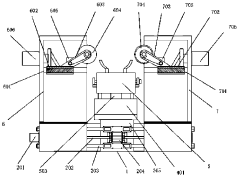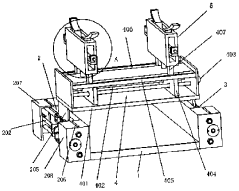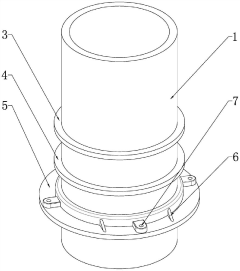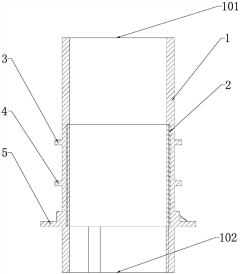HDPE's Contribution to Future City Infrastructure
HDPE in Urban Development: Background and Objectives
High-density polyethylene (HDPE) has emerged as a pivotal material in shaping the infrastructure of future cities. As urban populations continue to grow and environmental concerns intensify, the demand for sustainable, durable, and cost-effective building materials has never been greater. HDPE, with its unique properties and versatility, stands at the forefront of this urban development revolution.
The evolution of HDPE in urban infrastructure can be traced back to its initial applications in the mid-20th century. Originally used primarily in packaging and household products, HDPE's potential in construction and infrastructure was gradually recognized. The material's resistance to corrosion, chemical inertness, and ability to withstand extreme temperatures made it an attractive option for various urban applications.
In recent years, the focus on sustainable urban development has accelerated the adoption of HDPE in city infrastructure. As municipalities worldwide strive to create resilient, eco-friendly cities, HDPE has found its way into numerous critical applications. From water and sewage systems to underground cable protection and stormwater management, HDPE pipes and structures have become integral components of modern urban landscapes.
The technological advancements in HDPE manufacturing and processing have further expanded its potential in urban development. Innovations in polymer science have led to the creation of HDPE variants with enhanced properties, such as improved strength-to-weight ratios and increased UV resistance. These developments have opened up new possibilities for HDPE in above-ground applications, including urban furniture, playground equipment, and even architectural elements.
The primary objective of incorporating HDPE into future city infrastructure is to address the complex challenges of urbanization while promoting sustainability. HDPE's long service life, recyclability, and low environmental impact align perfectly with the goals of creating circular economies within urban environments. By reducing the need for frequent replacements and minimizing waste, HDPE contributes to more efficient resource utilization in cities.
Furthermore, the adaptability of HDPE to various manufacturing processes, including 3D printing, positions it as a key material in the era of smart cities. The ability to rapidly prototype and produce customized HDPE components on-site could revolutionize urban repair and maintenance strategies, leading to more responsive and resilient city infrastructures.
As we look towards the future of urban development, the role of HDPE is expected to expand even further. Research is ongoing to explore new applications, such as HDPE-based composites for structural elements and innovative designs that maximize the material's properties. The integration of HDPE with other advanced materials and technologies promises to unlock new potentials in creating sustainable, efficient, and livable urban spaces for generations to come.
Market Analysis for HDPE in Infrastructure
The market for High-Density Polyethylene (HDPE) in infrastructure is experiencing significant growth, driven by the material's unique properties and the increasing demand for durable, cost-effective solutions in urban development. HDPE's resistance to corrosion, chemicals, and environmental stress makes it an ideal choice for various infrastructure applications, including water and sewer systems, gas distribution networks, and telecommunications conduits.
In the water management sector, HDPE pipes are gaining traction due to their longevity and leak-resistant properties. The global HDPE pipes market is projected to expand substantially, with a particular focus on water supply and wastewater management in rapidly urbanizing regions. This growth is further fueled by government initiatives to upgrade aging infrastructure and improve water distribution efficiency.
The gas distribution industry is another key driver for HDPE demand in infrastructure. As natural gas continues to play a crucial role in the energy mix of many countries, the need for safe and reliable gas transportation systems is paramount. HDPE pipes offer superior performance in terms of flexibility, joint integrity, and resistance to ground movement, making them increasingly preferred over traditional materials like steel or cast iron.
Telecommunications infrastructure represents a burgeoning market for HDPE products. The global push towards 5G networks and fiber-optic connectivity is creating a substantial demand for HDPE conduits and ducts. These components protect sensitive fiber-optic cables and provide easy installation and maintenance access, essential for the rapid expansion of high-speed internet networks in urban areas.
The construction industry's shift towards sustainable and long-lasting materials is also bolstering HDPE's market position. In applications such as geomembranes for landfills, drainage systems, and erosion control, HDPE offers superior environmental protection and durability compared to conventional materials.
Regionally, developing economies in Asia-Pacific and Africa are expected to be major growth drivers for HDPE in infrastructure. Rapid urbanization, coupled with large-scale infrastructure development projects, is creating substantial opportunities for HDPE applications. Meanwhile, in developed markets, the focus is shifting towards infrastructure rehabilitation and replacement, where HDPE's properties make it an attractive option for upgrading aging systems.
Despite the positive outlook, the HDPE market faces challenges from fluctuating raw material prices and competition from alternative materials. However, ongoing technological advancements in HDPE production and processing are expected to enhance its competitiveness and expand its application range in future city infrastructure projects.
Current HDPE Applications and Challenges
High-density polyethylene (HDPE) has become an integral component in modern urban infrastructure, offering a wide range of applications due to its exceptional properties. In the context of future city development, HDPE plays a crucial role in various sectors, including water management, telecommunications, and transportation.
One of the primary applications of HDPE in urban infrastructure is in water distribution systems. HDPE pipes are widely used for potable water supply, wastewater management, and stormwater drainage. These pipes offer excellent corrosion resistance, flexibility, and durability, making them ideal for underground installations. HDPE's resistance to chemicals and abrasion ensures a longer service life compared to traditional materials, reducing maintenance costs and minimizing water loss through leaks.
In the telecommunications sector, HDPE conduits are extensively used to protect fiber optic cables and other communication lines. The material's flexibility allows for easy installation in complex urban environments, while its strength protects the sensitive cables from external damage. As cities continue to expand their digital infrastructure, the demand for HDPE conduits is expected to grow significantly.
HDPE also finds applications in transportation infrastructure, particularly in the construction of culverts, bridge drainage systems, and noise barriers along highways. Its lightweight nature and ease of installation make it an attractive option for these applications, reducing construction time and costs.
Despite its widespread use, HDPE faces several challenges in urban infrastructure applications. One of the primary concerns is the material's susceptibility to UV degradation when exposed to sunlight for extended periods. This limitation necessitates the use of UV stabilizers or protective coatings in above-ground applications, potentially increasing costs and complexity.
Another challenge is the joining of HDPE components. While heat fusion techniques provide strong and reliable joints, they require specialized equipment and skilled operators. This can lead to increased installation costs and potential quality control issues in large-scale urban projects.
The environmental impact of HDPE production and disposal also presents a significant challenge. Although HDPE is recyclable, the recycling rates for infrastructure applications remain relatively low. Improving the recyclability and developing more efficient recycling processes for HDPE used in urban infrastructure is crucial for enhancing its sustainability profile.
As cities strive to become more resilient and sustainable, there is a growing need for HDPE to address emerging challenges such as climate change adaptation and smart city initiatives. Developing HDPE formulations with enhanced properties, such as improved thermal resistance or integrated sensor capabilities, could open up new applications in future urban infrastructure projects.
HDPE Solutions for Urban Infrastructure
01 Composition and properties of HDPE
High-Density Polyethylene (HDPE) is a thermoplastic polymer with a high strength-to-density ratio. It is characterized by its long linear chains with minimal branching, resulting in higher tensile strength, stiffness, and chemical resistance compared to other polyethylene types. HDPE's properties make it suitable for various applications in packaging, construction, and automotive industries.- Composition and properties of HDPE: High-Density Polyethylene (HDPE) is a thermoplastic polymer with a high strength-to-density ratio. It is characterized by its long linear chains with minimal branching, resulting in higher tensile strength and chemical resistance compared to other polyethylene types. HDPE's properties make it suitable for various applications, including packaging, pipes, and industrial products.
- HDPE blends and composites: HDPE can be blended with other materials or reinforced with additives to enhance its properties. These blends and composites can improve characteristics such as impact resistance, thermal stability, and mechanical strength. Various fillers, fibers, and nanoparticles are used to create HDPE composites tailored for specific applications.
- HDPE processing techniques: Different processing techniques are employed to manufacture HDPE products. These include injection molding, extrusion, blow molding, and rotational molding. Each method offers unique advantages and is suited for specific product types. Advanced processing techniques aim to improve the efficiency and quality of HDPE product manufacturing.
- HDPE recycling and sustainability: Recycling of HDPE is crucial for environmental sustainability. Various methods are developed to recycle HDPE products, including mechanical recycling and chemical recycling. These processes aim to reduce waste and create a circular economy for HDPE materials. Innovations in recycling technology focus on improving the quality of recycled HDPE and expanding its applications.
- HDPE applications in various industries: HDPE finds applications in diverse industries due to its versatile properties. It is widely used in packaging, construction, automotive, and healthcare sectors. Specific applications include food packaging, water pipes, fuel tanks, medical devices, and consumer goods. Ongoing research focuses on expanding HDPE's use in emerging technologies and sustainable products.
02 HDPE blends and composites
HDPE can be blended with other materials or reinforced with additives to enhance its properties. These blends and composites can improve mechanical strength, thermal stability, or specific functional characteristics. Examples include HDPE mixed with natural fibers, nanoparticles, or other polymers to create materials with tailored properties for specific applications.Expand Specific Solutions03 HDPE processing techniques
Various processing techniques are used to manufacture HDPE products, including injection molding, extrusion, blow molding, and rotational molding. Each method offers unique advantages for producing different types of HDPE products, such as containers, pipes, films, and structural components. Innovations in processing techniques focus on improving efficiency, reducing cycle times, and enhancing product quality.Expand Specific Solutions04 Recycling and sustainability of HDPE
HDPE is highly recyclable, making it an environmentally friendly material. Recycling processes for HDPE involve collection, sorting, cleaning, and reprocessing into new products. Innovations in this area focus on improving recycling efficiency, developing new recycling technologies, and finding novel applications for recycled HDPE to promote circular economy principles.Expand Specific Solutions05 HDPE applications in various industries
HDPE finds extensive use in diverse industries due to its versatile properties. It is commonly used in packaging (bottles, containers), construction (pipes, geomembranes), automotive (fuel tanks, interior parts), and consumer goods (toys, household items). Ongoing research focuses on expanding HDPE applications, such as in 3D printing, advanced composites, and specialized industrial components.Expand Specific Solutions
Key HDPE Manufacturers and Suppliers
The HDPE market for future city infrastructure is in a growth phase, driven by increasing urbanization and the need for sustainable, durable materials. The market size is expanding globally, with significant potential in developing countries. Technologically, HDPE applications are mature but evolving, with ongoing innovations in material properties and manufacturing processes. Companies like SABIC Global Technologies BV, ExxonMobil Chemical Patents, Inc., and Celanese Polymers Holding, Inc. are at the forefront of HDPE technology development. Academic institutions such as Zhejiang University and Tianjin University are contributing to research and development. The competitive landscape is characterized by a mix of established petrochemical giants and specialized material manufacturers, with increasing focus on eco-friendly and high-performance HDPE solutions for urban infrastructure applications.
Anhui Glant Advanced Material Co., Ltd.
Kuraray Co., Ltd.
Innovative HDPE Technologies and Patents
- A high-modulus impact-resistant HDPE double-wall corrugated pipe is developed using a composition of high-density polyethylene, high-modulus PP, HDPE stiffening and toughening masterbatches, polyester modified acrylic resin, nano calcium carbonate, and glass fiber, processed through a specific mixing and extrusion method involving high-speed mixers and an exhaust platform with extrusion rollers to enhance mechanical properties and prevent deformation.
- Design a rigid embedded part of HDPE pipe including an annular metal sleeve, a first annular water-blocking ring, a second annular water-blocking ring and an annular fixing seat. By setting an annular metal sleeve inside the body, the thermal expansion and contraction deformation can be reduced, and the extension can be extended The seepage water path is improved, and the bite force with the floor is improved through the connecting ribs and mounting holes, and the flow is stabilized by combining with the diversion ribs.
Environmental Impact of HDPE Usage
The environmental impact of HDPE usage in future city infrastructure is a critical consideration that requires careful analysis. HDPE, or High-Density Polyethylene, offers numerous benefits for urban development, but its widespread use also raises concerns about long-term ecological consequences.
One of the primary environmental advantages of HDPE is its durability and longevity. HDPE pipes and structures can last for decades, reducing the need for frequent replacements and minimizing construction-related disruptions. This longevity translates to fewer raw materials consumed over time and reduced energy expenditure for manufacturing and installation processes.
However, the production of HDPE involves the use of fossil fuels, contributing to greenhouse gas emissions. The manufacturing process requires significant energy inputs, which can have a substantial carbon footprint if not managed sustainably. As cities strive to reduce their overall environmental impact, the sourcing and production methods of HDPE materials become crucial factors to address.
Recycling presents both an opportunity and a challenge for HDPE usage in urban infrastructure. HDPE is highly recyclable, and many cities have implemented recycling programs to divert plastic waste from landfills. Recycled HDPE can be used in various applications, including new infrastructure components, creating a circular economy model. However, the effectiveness of recycling programs varies widely, and contamination issues can hinder the recycling process.
The potential for microplastic pollution is another environmental concern associated with HDPE usage. As HDPE products degrade over time, they can release microscopic plastic particles into soil and water systems. This pollution can have far-reaching effects on ecosystems and potentially enter the food chain, impacting both wildlife and human health.
On the positive side, HDPE's resistance to corrosion and chemical degradation means that it does not leach harmful substances into the environment, unlike some alternative materials. This property is particularly beneficial in applications such as water distribution systems, where maintaining water quality is paramount.
The lightweight nature of HDPE also contributes to its environmental profile. Compared to traditional materials like concrete or metal, HDPE requires less energy for transportation and installation, potentially reducing the overall carbon footprint of infrastructure projects.
As cities continue to expand and modernize their infrastructure, the environmental impact of HDPE usage will remain a key consideration. Balancing the material's benefits with its potential drawbacks will require ongoing research, innovation in production techniques, and the development of comprehensive lifecycle assessment methodologies. Future urban planning must prioritize sustainable material choices and implement robust recycling and waste management strategies to mitigate the environmental impact of HDPE and similar materials in city infrastructure.
HDPE Recycling and Circular Economy
HDPE recycling and circular economy initiatives are becoming increasingly crucial in the context of future city infrastructure. As urban areas continue to expand and modernize, the demand for sustainable and recyclable materials has grown exponentially. HDPE, with its durability and versatility, plays a significant role in this circular economy model.
The recycling process for HDPE involves several stages, including collection, sorting, cleaning, and reprocessing. Advanced sorting technologies, such as near-infrared spectroscopy and artificial intelligence-driven systems, have greatly improved the efficiency and accuracy of HDPE separation from other plastics. This has led to higher quality recycled HDPE, which can be used in a wider range of applications.
In the circular economy model, HDPE products are designed with end-of-life considerations in mind. This approach ensures that materials can be easily disassembled, recycled, and reintegrated into new products. For instance, HDPE pipes used in city infrastructure can be recycled into new pipes or other HDPE products, reducing the need for virgin materials and minimizing waste.
The implementation of HDPE recycling programs in cities has shown significant environmental and economic benefits. Studies have demonstrated that recycling HDPE consumes less energy and produces fewer greenhouse gas emissions compared to manufacturing virgin HDPE. Additionally, the recycling industry creates jobs and stimulates local economies, contributing to the overall sustainability of urban areas.
Innovations in HDPE recycling technologies are continually emerging. Chemical recycling methods, such as pyrolysis and depolymerization, are being developed to complement mechanical recycling. These processes break down HDPE into its chemical components, allowing for the production of high-quality recycled materials that can meet stringent quality standards for various applications.
The integration of HDPE recycling into smart city initiatives is another promising area. IoT-enabled waste management systems can optimize collection routes, track recycling rates, and provide real-time data on material flows. This data-driven approach enhances the efficiency of recycling programs and helps cities make informed decisions about their waste management strategies.
As cities strive to become more sustainable and resilient, the role of HDPE in the circular economy will continue to grow. The development of closed-loop systems, where HDPE products are continuously recycled and reused within urban infrastructure, represents a key opportunity for reducing environmental impact and resource consumption in future cities.





